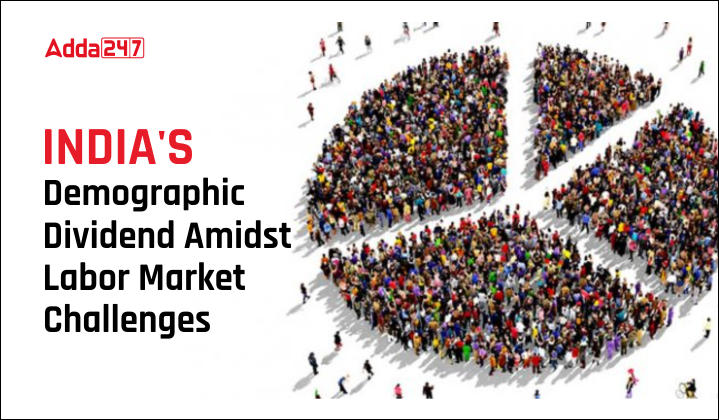Table of Contents
There was an article on this topic in the Hindu, which gives insights into India’s Labor Market and Trends. India is at a crucial juncture, enjoying the phase of its demographic dividend, which represents a period when the proportion of the working-age population is higher than the non-working-age share. This phase offers a unique opportunity for economic growth and development, as a larger workforce can potentially contribute more significantly to the country’s GDP. However, the real benefits of this demographic advantage hinge on the quality of employment and the productivity of the workforce.
Indian Labor Market Overview
High Dependency on Labor: A significant portion of Indians earn their living through labor rather than owning capital or land.
Informal Employment Predominance: Around 90% of the working population is engaged in informal employment characterized by a lack of job security, absence of employment benefits, no social protection, and lower earnings.
Sectors of Informal Employment: Informal workers are mainly found among casual laborers, self-employed individuals, and some regular wage or salaried workers.
Impact on GDP and Living Standards
GDP Growth vs. Labor Market: The real impact of GDP growth on the masses’ living standards hinges on labor market conditions, including job creation, quality of jobs, and wage improvements.
- Labor Market Dynamics: Analysis from PLFS Data
- Labor Force Participation Rate (LFPR): LFPR has shown an increase from 52.35% in 2017-18 to 58.35% in 2021-22, driven mainly by rural women, countering the long-term trend of declining LFPR post-liberalization.
- Unemployment Rate: A decline from 6.2% in 2017-18 to 4.2% in 2021-22, with a similar trend observed in youth unemployment rates.
Composition and Quality of Employment
Rise in Self-Employment: Notable increase in self-employment, especially among unpaid family workers, from 26% to 31.4%.
Stagnation among Regular Wage/Salaried Workers: Minimal growth in the proportion of regular wage or salaried employment, indicating a lack of quality job creation.
Earnings and Economic Well-being
- Moderate Increase in Earnings: All-India average real daily earnings saw a modest rise, with casual workers experiencing a 20% increase in earnings, a positive yet insufficient development considering the prevailing poverty lines.
Challenges in Harnessing Demographic Dividend and Economic
Growth
- Underutilization of Labor Capital: Most of the workforce engaged in low-quality, low-productivity work during India’s demographic dividend period, raising concerns over optimal labor capital utilization.
- Macro-Economic Implications: Stagnant earnings among the poorer sections impact consumer expenditure and demand-side economics, risking a vicious cycle of low investment and economic growth.
- Skill Mismatch and Education System: A significant challenge is the skill mismatch in the labor market. Despite high levels of formal education, many young Indians find themselves either unemployed or underemployed due to the education system’s failure to equip them with the skills that match market demand. Enhancing vocational training and linking education more closely with industry needs can help mitigate this issue.
- Digital Economy and Gig Work: The rise of the digital economy presents both opportunities and challenges. On one hand, it offers new avenues for employment and entrepreneurship, particularly in technology-driven sectors. On the other hand, the gig economy, characterized by freelance, part-time, and contract work, often lacks the social security and benefits associated with traditional employment, necessitating policy interventions for gig workers’ protection.
- Rural-Urban Divide: There is a pronounced rural-urban divide in employment opportunities and living standards. While urban areas tend to offer more formal employment opportunities, rural areas remain heavily dependent on agriculture and informal jobs. Bridging this divide requires focused investment in rural infrastructure, agribusiness, and non-farm job creation.
- Gender Disparities: Despite improvements, the labor force participation rate for women remains significantly lower than for men, highlighting the need for policies that encourage female participation in the workforce. This includes addressing social norms, providing safe and accessible work environments, and offering support for balancing work and family responsibilities.
- Migration and Labor Laws: Internal migration plays a crucial role in the labor market, with millions moving from rural to urban areas in search of better opportunities. However, migrants often face issues related to housing, social security, and labor rights. Reforming labor laws to ensure protection for migrant workers and improving their access to basic services are essential steps.
- Technology and Automation: Advancements in technology and automation pose both a threat and an opportunity for the labor market. While automation may displace some jobs, it also creates new jobs requiring higher skill levels. Preparing the workforce for this transition through upskilling and reskilling is critical.
- Environmental Sustainability and Green Jobs: As the world moves towards greener economies, there is a growing need to align job creation with environmental sustainability. Investing in renewable energy, sustainable agriculture, and green infrastructure can generate millions of jobs while addressing climate change.
- International Trade and Labor Standards: India’s engagement in international trade and its integration into global value chains can influence labor market dynamics. Ensuring that trade agreements include strong labor standards can help improve job quality and worker rights.
Conclusion
While superficial metrics like LFPR and unemployment rates show positive trends, a deeper analysis reveals underlying job quality, earnings, and overall economic well-being challenges. Addressing these issues is crucial to harnessing India’s demographic dividend effectively and ensuring sustainable economic growth.



 TSPSC Group 1 Question Paper 2024, Downl...
TSPSC Group 1 Question Paper 2024, Downl...
 TSPSC Group 1 Answer key 2024 Out, Downl...
TSPSC Group 1 Answer key 2024 Out, Downl...
 UPSC Prelims 2024 Question Paper, Downlo...
UPSC Prelims 2024 Question Paper, Downlo...
